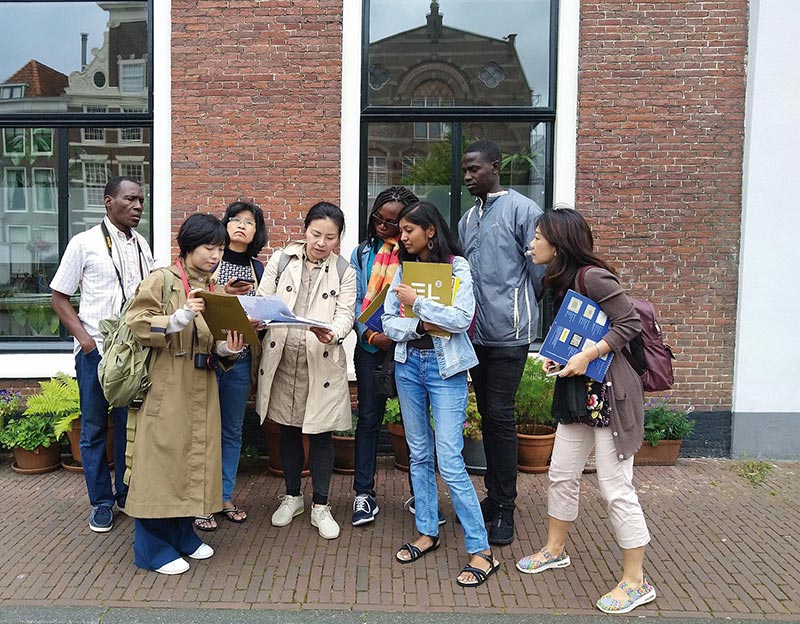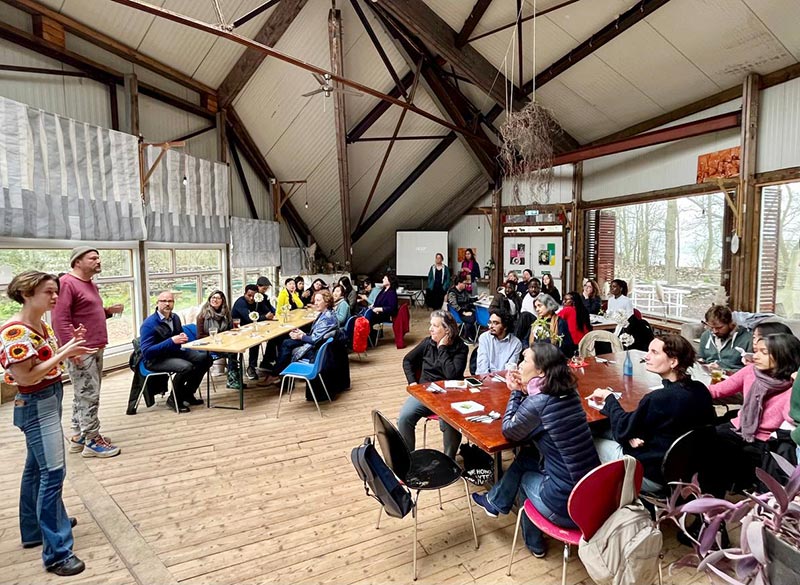From the director: Looking Back, Looking Forward. Three Decades of IIAS
The adventure represented by the small institute that is IIAS is difficult to convey in a short article. What should perhaps be stressed from the outset is its inherent plasticity, as an organization, in both its ways to operate and in the programmes it has been running. This built-in flexibility, reflected in the unique collective spirit that animates its team, is I believe the secret that has allowed IIAS to adjust, adapt, and (re-)position itself in the face of changing contexts, new challenges, and new opportunities.
First, the name of IIAS and the helpful ambiguities it contains: coined from its creation as both ‘international’ and focusing on ‘Asian Studies’, the way the institute has evolved somehow allowed it to transcend these notions that were purposefully chosen for their intrinsic elasticity. One now can say that IIAS is engaged in a local-global-local articulation rather than a reduced national-international one, even though the original adjective is what enabled it to move creatively beyond traditional boundaries. IIAS today is, in fact, associated with numerous locally situated ecologies of knowledge, which, through its panoply of activities and programmes, it helps link to each to each other in an inclusive trans-national and trans-regional perspective.
On ‘Asian Studies’, the metamorphosis has been even more radical with the acknowledgement that Area Studies as they operated in the West during and for a while after the Cold War period should now be understood through the multi-local articulation I just mentioned. In other words, no single-centered ‘expertise’ from and on any given ‘region’ or ‘area’ can claim comprehensive authority through one ‘superior’ gaze; rather, regional knowledge becomes ontologically meaningful if it is framed in conversation among equals with other geopolitically-culturally situated knowledge ‘centres’. This fluidity in the definition of ‘studies’ can also allow for a multiplicity of expressions encompassing different formats and genres. It allows, in the deeply interconnected and entangled world we live in, for multiple voices to participate as active co-creators of knowledge.

Fig. 2: Participants of the first Humanities Across Borders summer school, “Reading Leiden,” explore the built structures of the old city. (Photo courtesy of Cheryl Jacob, 2017)
Beyond its name, IIAS’s inherent agility can be gauged by the particular role, position, and status it occupies in the academic system. IIAS is a unique ‘specie’ in Academia. Not a part of a university per se, though supported by one, its existence as an independent, multifaceted, interdisciplinary facilitating platform serving a multiplicity of stakeholders in Asia, The Netherlands, Europe, and the rest of world, is also a reflection on how ‘Asia’ as a global multidimensional human ‘factor’ is by definition pervasive everywhere.
Unbound by convention or baggage of some sorts, prone to explore new modes of exchange, the institute has largely contributed to transforming traditional patterns of knowledge creation, emphasizing the need for an inclusive, humanistic approach. After 30 years of existence, IIAS has become a trusted partner not only in Asia and Europe, but in what we now call the Global South. The institute draws this trust from its fundamentally collaborative nature, one privileging reciprocal arrangements built on non-hierarchical collegiality and mutuality.
Many of IIAS’s successful networks have been shaped around collectively defined objectives ranging from research-based thematic inquiries (e.g., ‘Neighborhoods’, ‘River-Cities’), to ones centered on shared aspirations, like for instance the ‘Africa-Asia’ platform, itself an extension of the broad meeting-grounds that are ‘International Convention of Asia Scholars’ (ICAS) events. With time, the often unplanned convergences among different actors have crystalised into vibrant coalitions of partners willing to leverage each other’s contribution for the sake of common interest. For instance, an unusual network like the groundbreaking pedagogical ‘Humanities Across Borders’ (HAB) was forged around a shared aspiration in both the ‘South’ and the ‘North’ to creatively rethink aspects of academic education beyond old practices and canons. The point to stress here is that IIAS, thanks to its inborn versatility and deep-seated humanistic grounding, has been able to explore numerous areas of intervention in an innovative serendipitous way in the service of an increasingly diverse array of publics and partners.
Gradually and incrementally, the institute was able to articulate its unique role – its ‘niche’ – around a coherent assortment of facilitating functions, each and all aimed at supporting academic activities in regard to ‘Asia-in-the-world’. These are: (1) research facilitation, (2) pedagogical support, (3) knowledge dissemination, (4) knowledge community building, and (5) capacity building and civic engagement. On all of these ‘fronts’, I can confidently say that IIAS has largely contributed to reshaping not just the ‘field’ of Asian Studies, but the way cross- and trans-disciplinary, inter-cultural, collaborative scholarship should go, precisely beyond Asian/Area Studies, as they still operate in many academic settings.
One can point to a few of IIAS’s achievements – and to the way collaborative mechanisms have been mobilised and perfected – by always inserting new spaces of engagement allowing new intellectual explorations, to appreciate how old-school Area Studies practices have been disrupted.
Take for instance the ICAS conference or conventions. Their different metamorphoses, from the first traditional academic event in 1998 to the locally embedded conference-festival model of the last editions – and especially now, as we reimagine academic meetings in the post-COVID era – have made sure that these major exchange opportunities can continue to operate as indispensable junctures for new forms of intellectual inter-cultural interactions.
I could say the same about The Newsletter and the many mutations it has undergone, with a wide array of sections, formats, and forums. Integrating innovative possibilities like those offered by the digital media, our outlets continue to serve as the indispensable space of expression for knowledge dissemination related to Asia and Asia in the world, for an ever-expanding and diversified audience. Here, the conceivers of The Newsletter presciently imagined a publication that would not be constrained by the imperious demands of quantitative evaluation, as are traditionally assigned to academic journals. The bet was, and still is, that people of multiple academic backgrounds and walks of life wish to grasp the wide spectrum of research or modes of expression carried out in and on Asia so as to inform their own scholarship, taken thus as a contribution to a larger – humanistic – undertaking. To my knowledge, there are no equivalent publication outlets operating at such a level of inclusiveness in other region-focused academic ‘fields’. The Newsletter itself has evolved tremendously to take heed of otherwise unheard voices and perspectives, contributing to democratising the very act of producing knowledge.

Fig. 3: IIAS fellows and staff explore Brienenoord Island in the river Nieuwe Maas, led by ARK, an NGO working with the municipality of Rotterdam on a project called Rewilding of the City, 2023.
I could mention other IIAS initiatives built on the same craving for real inclusiveness – in essence, decolonial aspirations – as they are articulated in network-based platforms such as the Humanities Across Borders programme for education, the Urban Knowledge Network Asia initiative, with its two more specialized offshoots: Southeast Asia Neighborhoods Network and the River Cities Network, both aimed at engaging academic and non-academic actors in the production of more civically situated knowledges. I could also include the recently transformed IIAS Fellowship Programme, which not only seeks to embrace a more differentiated range of individual profiles and backgrounds, but also strives to imbue fellows with the emancipatory experience of engaging in collegial participatory activities, diversifying exposures, taking advantage of the wide range of activities that the institute offers. All of this is intended to broaden rather than restrict their individual – possibly even professional – horizons, beyond the straightjacket ultra-specialised profiling usually ascribed to them in mainstream academia.
To conclude this longer than usual piece, I think I can describe the progressive strategic re-orientation IIAS has been pursuing in today’s context of shifting paradigms and hierarchies: through the five functions mentioned above, IIAS’s original Area Studies mission has moved to one seeking global-local, inter-cultural, collaborative understanding. As I see it, to embrace the tectonic geo-political and -economic changes that we see emerging today, IIAS must deepen its partnerships with institutions and colleagues, notably from those in the ‘Southern’ regions of the world in Asia and beyond. This stance, from a North-based organization that is IIAS, should also help recast Western academic scholarship as an ever innovative benevolent-thus-necessary-and-respected player, beyond yesterday’s old Area Studies paradigms.
Philippe Peycam is Director at IIAS.
p.m.f.peycam@iias.nl